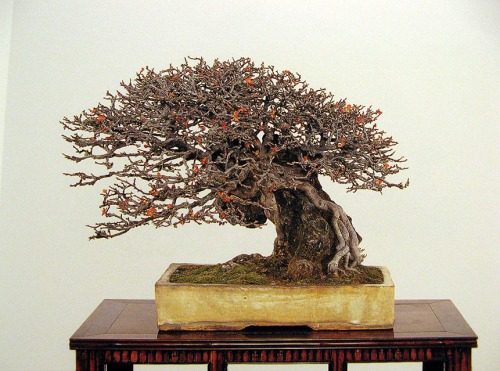It seems the Japanese themselves took a while to really see this plant, too. Historically Chojubai appeared commonly as a small accent plant in the Kokufu show forty years ago, as an unramified twig or two. Only rarely was it seen as a primary tree in the medium size category, and never in the large size. It was a second tier tree. Then something shifted. Around 1990 we began to see large size Chojubai in the Japanese shows. These were trees about 1-1.5 feet tall and twice as wide, multiple-trunked and highly ramified. Occasionally single-trunked trees, which are rare, were seen. In Kokufu book 80, about six years ago, two Chojubai won Kokufu prizes. Two years later in book 82 another won. Chojubai had come of age.
Like many trees before, including our standby the juniper which was once not too highly considered, there was a shift in attitude toward Chojubai. It began to be taken seriously, and so technique was applied to it to foresee a new future. And then everything in bonsai—or art for that matter—seems to pass through a period of absurdity, where the material is pushed to limits of control, and then eventually relaxing from that extreme place. Conifers wired to within microns of position… the grafted pancake nebaris of maples looking like tree jokes…but eventually it dials down a bit to some sanity over the material and the technique, and to the willingness of artists to allow for what the tree brings to the table. In the case of Chojubai, perfect dome trimming seems to limit the expression of the innate character of the plant—which would be the eccentricity and unexpected angles and directions in the branching. If this were a plant trained by music, that music would be jazz.
For those who would grow Chojubai, keep it moist. Plant in deeper containers to hold more water. Keep in the sun. Use a pesticide when shoots are elongating to control aphids. Wire main branches and shoots from the base for multiple trunks, and cut and grow following that. This is not so much to create branch taper, as there will be little of that, but for the short, zigzagging and erratic branching that is only created by many years of scissor work. Leave one to three internodes only. Always immediately remove shoots that come from the base that you are not intending to use as trunks—they will weaken the older areas.
If you have a Chojubai, you have one of the rare shrubs that can live more than 100 years and only gets better and better. If you like something, become a connoisseur of it! With attention and focus, even the lowliest plant can become elegant and distinguished.
Chojubai Gallery:

Most Chojubai are enjoyed out of leaf, although the small glossy leaves are perfectly in scale. As Chojubai often flowers nearly year-round there is nothing stopping you from putting them on the display tables any day of the year. 30 cm

You might wonder why I put this in...Well, it is a Chojubai accent plant in the Kokufu show 40 years ago. Interesting, isn't it, how tastes and techniques have changed? These days, this tree would be unlikely to even get accepted into a local Western bonsai club show.

The vast majority of Chojubai grown for bonsai are the red-flowered variety; all the other photos in this gallery are of red-flowered trees. This is a white-flowered tree and it won a Kokufu prize. Very hard to ramify the white ones. 33 cm

A red-flowered Kokufu prize winner. Very old. This is a good example of the extremes in technique used to create a very crystalized form. Impressive, and yet in some ways perhaps not showing the best of what Chojubai offers. Hmm, I wonder how long I will be in purgatory for that comment... 35 cm

One of the rarer single-trunked Chojubai. Another Kokufu prize winner. If you have a single-trunked tree, be very sure to cut all suckers that come from the root base. Beautiful old tree! The warty bark is evident only with great age. 38 cm





0 comments:
Post a Comment